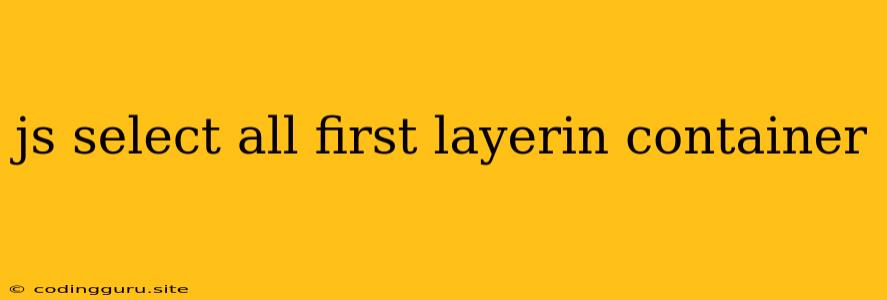Selecting Elements within a Container: A Deep Dive into JavaScript
In the dynamic world of web development, manipulating elements on a page is crucial. Often, you need to target specific elements within a container without getting caught in a web of nested elements. This is where JavaScript shines, empowering you to select and interact with elements with precision.
The Need for Precision: Why Select First-Layer Elements?
Imagine you have a shopping cart page with multiple product items. Each product item has its own container, holding the image, name, price, and a "Add to Cart" button. Now, you want to add event listeners to all the "Add to Cart" buttons. The challenge? These buttons might be nested within multiple divs, creating a complex structure.
Using plain document.querySelectorAll might grab elements outside the container, leading to unintended consequences. This is where the power of selecting first-layer elements within a container comes into play. It allows you to target specific elements, ensuring your code interacts with the correct elements and avoids unexpected behavior.
Techniques for Selecting First-Layer Elements
JavaScript offers a handful of methods to select first-layer elements. Let's explore some of the most common techniques:
1. children Property
The children property is your go-to for selecting direct children elements of a container. It provides a live HTMLCollection, which dynamically reflects changes to the DOM.
const container = document.getElementById('product-container');
const children = container.children;
for (let i = 0; i < children.length; i++) {
console.log(children[i]);
}
This code snippet iterates through all direct children of an element with the ID 'product-container'.
2. querySelectorAll with the > Selector
The > selector in querySelectorAll specifically targets direct children. It's a powerful way to select elements based on a particular class or tag name within a container.
const container = document.getElementById('product-container');
const buttons = container.querySelectorAll('> button');
buttons.forEach(button => {
button.addEventListener('click', () => {
// Handle button click
});
});
This code selects all buttons that are direct children of the container with the ID 'product-container' and attaches click event listeners to them.
3. querySelector with the > Selector
Similar to querySelectorAll, querySelector with the > selector selects the first matching direct child element within the container.
const container = document.getElementById('product-container');
const firstButton = container.querySelector('> button');
firstButton.addEventListener('click', () => {
// Handle button click
});
This code selects the first button that is a direct child of the container with the ID 'product-container'.
4. element.firstElementChild
This property selects the first child element of a container, similar to querySelector with > but without the need for a selector.
const container = document.getElementById('product-container');
const firstChild = container.firstElementChild;
firstChild.addEventListener('click', () => {
// Handle click
});
This code selects the first child element of the container with the ID 'product-container'.
5. element.lastElementChild
This property selects the last child element of a container.
const container = document.getElementById('product-container');
const lastChild = container.lastElementChild;
lastChild.addEventListener('click', () => {
// Handle click
});
This code selects the last child element of the container with the ID 'product-container'.
Tips for Efficient Selection
-
ID Selectors: When possible, use ID selectors (e.g.,
document.getElementById) for faster and more specific selection. IDs are unique within a document, making them highly efficient. -
Class Selectors: For multiple elements with similar functionalities, use class selectors (e.g.,
document.querySelectorAll('.product-item')). -
Caching: Cache frequently used elements to avoid repetitive DOM lookups.
Example: Dynamic Product List
Let's illustrate this with a practical example:

Product Name 1
Product description

Product Name 2
Product description
JavaScript
const container = document.getElementById('product-container');
const buttons = container.querySelectorAll('> div > button');
buttons.forEach(button => {
button.addEventListener('click', () => {
const productItem = button.parentNode; // Get the parent product item
const productName = productItem.querySelector('h3').textContent;
// Handle the click, for example, display an alert
alert(`Added ${productName} to Cart`);
});
});
In this example, we use the > selector to target all "Add to Cart" buttons that are direct children of div elements within the product-container. We then use the parentNode property to access the parent product-item container and extract the product name from the <h3> element.
Conclusion
Selecting first-layer elements within a container is a fundamental skill in JavaScript. By utilizing methods like children, querySelectorAll, and querySelector with the > selector, you can effectively target specific elements within complex structures. Understanding these techniques helps you write cleaner, more efficient, and more maintainable JavaScript code, ensuring your applications function seamlessly and deliver a smooth user experience.
